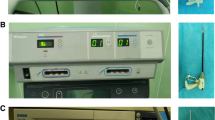Abstract
Background
The reported literature suggests a higher incidence of collateral damage during energized dissections in laparoscopic surgery than in open surgery, probably because the ambient environment of the two approaches causes different heat absorbance and thermal spread during energized dissection.
Methods
The experimental design involved randomized allocation of the surgical approach (4 open and 4 laparoscopic procedures) for eight adult pigs. A bipolar electrosurgery system (LigaSure) was used to perform 40 standardized regional dissections and procedures (5 per animal in randomized order). During these procedures, both white light and infrared thermographic imaging (3–5 μm) were recorded, and biopsy specimens were procured for histology.
Results
The core body temperatures were significantly different between the two approaches. The laparoscopic group had a smaller temperature drop (3.08 ± 0.98°C vs 1.9 ± 0.72°C; p = 0.03). Differences also were observed in the thermal spread between the laparoscopic and open groups during portal vein dissection with the Advance (1.7 ± 0.2 mm vs 2.3 ± 1.7 mm; p = 0.07). Both thermography and histology confirmed the safety of the LigaSure system in limiting thermal spread and necrosis at the fusion line. Significant degradation of the instruments began after 10 activations. The deterioration was faster and more extensive in laparoscopic surgery.
Conclusions
Heat absorbance and thermal spread during bipolar electrosurgery are significantly different between open and laparoscopic surgery. Device performance degradation with repeat activations is more marked in laparoscopic surgery.



Similar content being viewed by others
References
Wu MP, Ou CS, Chen SL, Yen E, Rowbotham R (2000) Complications and recommended practices for electrosurgery in laparoscopy. Am J Surg 179:67–73
Nduka CC, Super PA, Monson JRT (1994) Cause and prevention of electrosurgical injuries in laparoscopy. J Am Coll Surg 179:161–170
Tang B, Hanna GB, Joice P, Cuschieri A (2004) Identification and categorization of technical errors by observational clinical human reliability assessment (OCHRA) during laparoscopic cholecystectomy. Arch Surg 139:1215–1220
Massarweh NN, Cosgriff N, Slakey DP (2006) Electrosurgery: history, principles and current and future uses. J Am Coll Surg 202:520–530
Amaral JF (1994) The experimental development of an ultrasonically activated scalpel for laparoscopic use. Surg Laparosc Endosc 4:92–99
Hoening DM, Chrostek CA, Amaral JF (1996) Laparoscopic coagulation shears: alternative method of hemostatic control of unsupported tissue. J Endourol 10:431–433
Kennedy JS, Stranahan PL, Taylor KD, Chandler JG (1998) High-burst-strength feedback-controlled bipolar vessel sealing. Surg Endosc 12:876–878
Heniford BT, Matthews BD, Sing RF, Backus C, Pratt B, Greene FL (2001) Initial results with an electrothermal bipolar vessel sealer. Surg Endosc 15:799–801
Wattiez A, Khandwala S, Bruhat M (1995) Electrosurgery in operative endoscopy. Blackwell Science, Oxford
Bass LS, Treat MR (1995) Laser tissue welding: a comprehensive review of current and future clinical applications. Lasers Surg Med 17:315–349
Tarek AE, Cuschieri A (2003) How safe is high-power ultrasonic dissection? Ann Surg 237:186–191
Campbell PA, Creswell AB, Frank TG, Cuschieri A (2003) Real-time thermography during energized vessel sealing. Surg Endosc 17:1640–1645
Chelsea AS, Schechter DA, Tetzlaff P, Baily A, Dycus S, Cosgriff N (2004) Method for creating ideal tissue fusion in soft tissue structures using radiofrequency (RF) energy. Surg Tech Int 13:49–55
Salameh JR, Schwartz JH, Hildebrandt DA (2006) Can LigaSure seal and divide the small bowel? Am J Surg 191:791–793
Smulders JF, de Hingh I, Stavast J, Jackimowicz JJ (2007) Exploring new technologies to facilitate laparoscopic surgery: creating intestinal anastomosis without sutures or staples using a radiofrequency-energy-driven bipolar fusion device. Surg Endosc 21:2105–2109
Song C (2006) Seeing the heat: development and evaluation of an infrared endoscope. Congress of the European Association of Endoscopic Surgery, Berlin
Song C, Tang B, Campbell PA, Frank TG, Cuschieri A (2007) An infrared endoscope for energised laparoscopic surgery. SAGES, Las Vegas
Kinoshita T, Kanehira E, Omura K, Kawakami K, Watanabe Y (1999) Experimental study on heat production by a 23.5-kHz ultrasonically activated device for endoscopic surgery. Surg Endosc 13:621–625
Ng Y, Song C, McLean D, Shimi SM, Frank T, Campbell PA, Cuschieri A (2003) Optimised deployment of heat-activated staples using thermography. Appl Phys Lett 83:1884–1886
Brukilacchio TJ, Bonnell LJ, Leiner DC (1997) Infrared endoscopic imaging system. SPIE Proc Infrared Tech Appl XXIII 3061:317–326
Bonnell LJ, Leiner DC, Brukilacchio T (1998) Endoscope for imaging infrared emissions within the range of 2 to 14 microns. U.S. patent no. 5,833,596
Roberts WW, Dinkel TA, Schulam PG, Bonnell L, Kavoussi LR (1997) Laparoscopic infrared imaging. Surg Endosc 11:1221–1223
Cadeddu JA, Jackman SV, Schulam PG (2001) Laparoscopic infrared imaging. J Endourol 15:111–116
Ogan K, Roberts WW, Wilhelm DM, Bonnell L, Leiner D, Lindberg G, Kavoussi L, Cadeddu J (2003) Infrared thermography and thermocouple mapping of radiofrequency renal ablation to assess treatment adequacy and ablation margins. Urology 62:146–151
Bancroft JD, Gamble M (2002) Theory and practice of histological techniques. In: Fixation and fixatives, 5th edn, Chap 5. Churchill Livingstone, Edinburgh
Acknowledgments
The authors are grateful to Mr. David Kellock and Dr. Neil Kernohan, who undertook the histology work. Prof. A. Cuschieri and Dr. P. Campbell thank the UK EPSRC for grant support and Covidien for providing the LigaSure system and bipolar devices.
Author information
Authors and Affiliations
Corresponding author
Rights and permissions
About this article
Cite this article
Song, C., Tang, B., Campbell, P.A. et al. Thermal spread and heat absorbance differences between open and laparoscopic surgeries during energized dissections by electrosurgical instruments. Surg Endosc 23, 2480–2487 (2009). https://doi.org/10.1007/s00464-009-0421-7
Received:
Revised:
Accepted:
Published:
Issue Date:
DOI: https://doi.org/10.1007/s00464-009-0421-7




